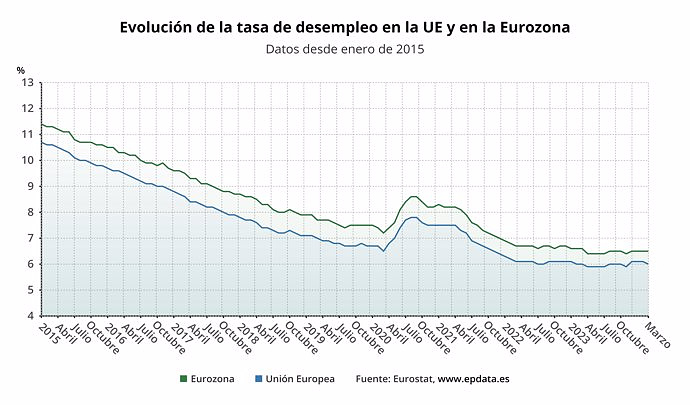Economic Team warns that debt forgiveness is far from criteria of general interest, while promoting moral risk
MADRID, 21 Abr. (EUROPA PRESS) -
Spain is the country in the European Union with the highest level of regional debt in terms of GDP among those in which the regions have the greatest powers, ahead of Belgium, Germany and Austria.
This is clear from the latest report by the Economic Team entitled 'Deficit and debt of the Autonomous Communities: high disparities', which analyzes the economic-financial situation of the Spanish autonomies.
According to the latest data available from Eurostat corresponding to the third quarter of 2023, the report warns that Spain had a regional debt of 22.3% of GDP, higher than that of Belgium (17.9%), Germany (15.3% ) and Austria (5.3%).
The analysis of regional debt is especially relevant, since the debt of the autonomous communities as a whole has grown from 6.1% of GDP in 2000 to 22.2% of GDP in 2023.
Although it was below that recorded in terms of GDP a year before, the decrease in the ratio was due to the increase in nominal GDP and its impact on the denominator, since in the numerator the debt in nominal terms increased by 2 .6%, up to 325,234 million euros, according to the study.
There are strong divergences in terms of debt between the different communities: Catalonia is the community with the highest levels of debt in absolute terms in 2023, with nearly 86,000 million euros and representing 26.4% of the Spanish regional debt alone. . This region is followed by the Valencian Community (almost 58,000 million and 17.8% of the total), Andalusia (more than 38,500 million; 11.9%) and the Community of Madrid (almost 36,000 million; 11%).
However, the highest levels of debt in terms of regional GDP were recorded in 2023 in the Valencian Community (42.2%), Castilla-La Mancha (31.9%), the Region of Murcia (31.2%) and Catalonia (31%).
Likewise, the report indicates that some autonomies continue to make very intensive use of the financing provided by the Financing Fund, despite it being a mechanism designed in 2012 on an extraordinary basis. So at the end of 2023, 60.9% of their debt position had the State as a creditor, according to data from the Bank of Spain. Meanwhile, several autonomies have not gone out to finance themselves in the markets for years.
As a result, there are important differences in the composition of the debt of the different Spanish regions, so that the relevant role of the State as a creditor is clearly evident in the Region of Murcia (92.9% of its debt is es with the State), Cantabria (92.8%), the Valencian Community (86.4%) and Catalonia (86.2%).
On the opposite side, the two provincial regions (Navarra and the Basque Country) and the Community of Madrid are not currently indebted to the State through these mechanisms. Debt levels with the State are relatively low (less than 25%) in the cases of Castilla y León, Asturias, the Canary Islands and Galicia. None of these seven regions received transfers from the State through these mechanisms in 2023.
For their part, the communities with a higher percentage of debt in representative securities are the Basque Country (67.2%) and the Community of Madrid (59%), which have also continued to go out to finance themselves in the markets this year.
However, the Economic Team warns about the communities' general non-compliance with the deficit objectives, their high levels of debt and their high dependence on the State for their financing.
For this reason, experts insist that it is especially relevant that communities take "co-responsibility" in the necessary process of fiscal consolidation of the Spanish Public Administrations.
In fact, the report recalls that fiscal consolidation for all Spanish administrations will be required by the EU in the context of the reform of European fiscal rules, which is expected to take effect with regard to 2025 budget planning.
Also for the recovery of the validity of the Spanish tax rules. According to current budgetary objectives, the communities subsector must achieve budgetary stability already during this year 2024 and a surplus of 0.1% of GDP in 2025 and 2026.
Finally, the Economic Team points out that the measures that are being announced in the current legislature, related to the forgiveness of part of the regional debt, are far from the application of economic criteria based on the general interest, at the same time that they promote the moral hazard.
On the contrary, experts warn that the very disparate situation between the autonomous communities in terms of deficit and debt, and the creditor role of the State, can only be successfully addressed through a comprehensive approach based on the principle of fiscal co-responsibility and cost containment, also within the framework of a reform of the regional financing system.

 Exploring Cardano: Inner Workings and Advantages of this Cryptocurrency
Exploring Cardano: Inner Workings and Advantages of this Cryptocurrency Seville.- Economy.- Innova.- STSA inaugurates its new painting and sealing hangar in San Pablo, for 18 million
Seville.- Economy.- Innova.- STSA inaugurates its new painting and sealing hangar in San Pablo, for 18 million Innova.- More than 300 volunteers join the Andalucía Compromiso Digital network in one month to facilitate access to ICT
Innova.- More than 300 volunteers join the Andalucía Compromiso Digital network in one month to facilitate access to ICT Innova.-AMP.- Ayesa acquires 51% of Sadiel, which will create new technological engineering products and expand markets
Innova.-AMP.- Ayesa acquires 51% of Sadiel, which will create new technological engineering products and expand markets Khan is re-elected mayor of London and underpins Labor's victory in local elections
Khan is re-elected mayor of London and underpins Labor's victory in local elections Felipe VI swears the flag again 40 years later at the AGM with Princess Leonor as a witness
Felipe VI swears the flag again 40 years later at the AGM with Princess Leonor as a witness Freixenet and unions agree to reduce working hours by 20-50% this year due to the drought
Freixenet and unions agree to reduce working hours by 20-50% this year due to the drought STATEMENT: Nearly 400 people participate in the II Family Support Conference at UIC Barcelona
STATEMENT: Nearly 400 people participate in the II Family Support Conference at UIC Barcelona How Blockchain in being used to shape the future
How Blockchain in being used to shape the future Not just BTC and ETH: Here Are Some More Interesting Coins Worth Focusing on
Not just BTC and ETH: Here Are Some More Interesting Coins Worth Focusing on A sensor system obtains the fingerprint of essential oils and detects if they have been adulterated
A sensor system obtains the fingerprint of essential oils and detects if they have been adulterated Faraday UPV presents the 'Origin' rocket to exceed 10 km of flight: "It is the beginning of the journey to space"
Faraday UPV presents the 'Origin' rocket to exceed 10 km of flight: "It is the beginning of the journey to space" The Generalitat calls for aid worth 4 million to promote innovation projects in municipalities
The Generalitat calls for aid worth 4 million to promote innovation projects in municipalities UPV students design an app that helps improve the ventilation of homes in the face of high temperatures
UPV students design an app that helps improve the ventilation of homes in the face of high temperatures A million people demonstrate in France against Macron's pension reform
A million people demonstrate in France against Macron's pension reform Russia launches several missiles against "critical infrastructure" in the city of Zaporizhia
Russia launches several missiles against "critical infrastructure" in the city of Zaporizhia A "procession" remembers the dead of the Calabria shipwreck as bodies continue to wash up on the shore
A "procession" remembers the dead of the Calabria shipwreck as bodies continue to wash up on the shore Prison sentences handed down for three prominent Hong Kong pro-democracy activists
Prison sentences handed down for three prominent Hong Kong pro-democracy activists ETH continues to leave trading platforms, Ethereum balance on exchanges lowest in 3 years
ETH continues to leave trading platforms, Ethereum balance on exchanges lowest in 3 years Investors invest $450 million in Consensys, Ethereum incubator now valued at $7 billion
Investors invest $450 million in Consensys, Ethereum incubator now valued at $7 billion Alchemy Integrates Ethereum L2 Product Starknet to Enhance Web3 Scalability at a Price 100x Lower Than L1 Fees
Alchemy Integrates Ethereum L2 Product Starknet to Enhance Web3 Scalability at a Price 100x Lower Than L1 Fees Mining Report: Bitcoin's Electricity Consumption Declines by 25% in Q1 2022
Mining Report: Bitcoin's Electricity Consumption Declines by 25% in Q1 2022 Oil-to-Bitcoin Mining Firm Crusoe Energy Systems Raised $505 Million
Oil-to-Bitcoin Mining Firm Crusoe Energy Systems Raised $505 Million Microbt reveals the latest Bitcoin mining rigs -- Machines produce up to 126 TH/s with custom 5nm chip design
Microbt reveals the latest Bitcoin mining rigs -- Machines produce up to 126 TH/s with custom 5nm chip design Bitcoin's Mining Difficulty Hits a Lifetime High, With More Than 90% of BTC Supply Issued
Bitcoin's Mining Difficulty Hits a Lifetime High, With More Than 90% of BTC Supply Issued The Biggest Movers are Near, EOS, and RUNE during Friday's Selloff
The Biggest Movers are Near, EOS, and RUNE during Friday's Selloff Global Markets Spooked by a Hawkish Fed and Covid, Stocks and Crypto Gain After Musk Buys Twitter
Global Markets Spooked by a Hawkish Fed and Covid, Stocks and Crypto Gain After Musk Buys Twitter Bitso to offset carbon emissions from the Trading Platform's ERC20, ETH, and BTC Transactions
Bitso to offset carbon emissions from the Trading Platform's ERC20, ETH, and BTC Transactions Draftkings Announces 2022 College Hoops NFT Selection for March Madness
Draftkings Announces 2022 College Hoops NFT Selection for March Madness
























